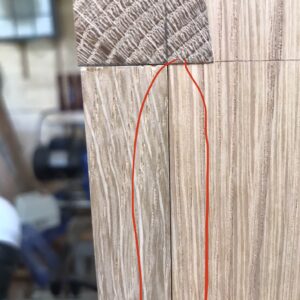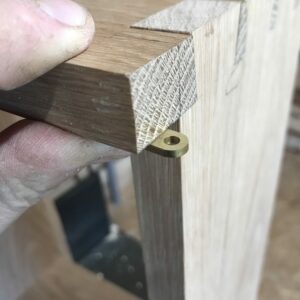Hi,
I am installing a door on a small cabinet and I want to use knife hinges. I have not done this before. Do I need a gap beteeen the door and the cabinet (marked with ref cirkle) if i have the turning point of the hinge out as in the other photo? I think it will be fine but I wanted to check here before I start the router.
thank you

















Replies
FWW has a site called "How to Install Knife Hinges", and recommends using shims - "For a consistent reveal around a door, use shims the same thickness as the hinge washer. Many varieties of plastic laminate are the right thickness, but cardboard and other materials will often work as well." Here's the link - https://www.finewoodworking.com/2010/12/29/how-to-install-knife-hinges
Thank you for your answer.
I cant really see that the article covers my question, but maybe I just didn´t understand it correctley. I am concerned about the door binding against the cabinet.
Without an install sheet for the hinges testing it is the only real way to see if it will bind. It will also refine your process in advance of hacking into your project. Moving the hinges in and out from the face of the door might help with swing clearance and the gap-free look.
Thank you for your answer.
Yes I thought about testing it, but I thought I would check in here first if anybody had tried it before.
It looks from your photo you have "straight" knife hinges (as opposed to offset knife hinges)...this is an important difference. The question you are asking, I believe, is whether you need to shim the door away from the case? This is why offset knife hinges exist--so that as the door pivots, the axis of the pin creates enough space for the door frame to clear the case front. I would get a set of offset knife hinges -- I swear by the Brusso hinges. If you stay with the straight model...I think you'll have to mortise everything so the pivot end of each hinge sticks out from the case/door side, or you can radius the inside corners of the door frames? Neither of those are very elegant solutions.
If you've not installed knife hinges before...practice on some scrap first. They are very fussy. The mortises need to be perfectly fit or the door won't swing sweetly. Generally, I think it is easiest to mark for them on the dry-fitted case, disassemble and then cut the mortises (before glue up). After the case is glued and the doors fitted, you cut the corresponding mortises in the door rails. Also, I find it easiest to mount the "pin half" of the hinge in the case and the other with the hole in the doors. When you mount the doors you have to slide the door not assembled hinge and then screw them in (an extra set of hands is good here).
I would want a gap although a very small one. If the door rests directly against a large or long surface on the case it may be difficult to get it to operate well throughout the seasons. A door is going to be happier resting against a specific stop as opposed to against the case IMHO.
This forum post is now archived. Commenting has been disabled